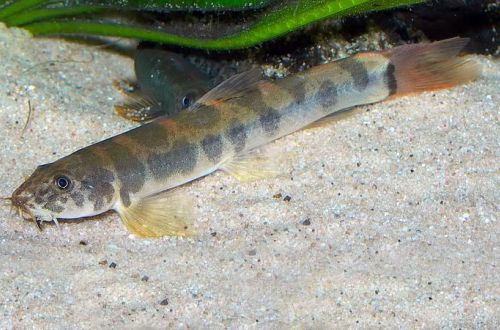
Plecostomus Orinoco
Plecostomus Orinoco, scientific name Hypancistrus contradens, belongs to the family Loricariidae (Mail catfish). Another common name is also “Polka Dot Plecostomus” because of the characteristic body pattern.

Contents
Habitat
Native to South America. It is considered endemic to a section of the Orinoco River Basin, located in Venezuela. Found everywhere. It lives in the bottom layer in places with a lot of natural shelters, such as snags, thickets of plants, etc.
Description
Adults reach a length of about 12 cm. The fish has a flattened body with a large triangular head (when viewed from above). The eyes are located high on the top of the head, and the mouth is on the back of the head, below.
The coloration is dark with a pattern of large rounded dots of light color. Due to the similarity in coloration, this species is often confused with Inspector Hypancistrus, which can be distinguished by the black edging of unpaired fins.
Behavior and Compatibility
Calm peaceful fish. Strive to occupy the area at the bottom of the aquarium, where any shelter is located. Due to its size, it will not be able to compete for food with larger benthic species. Tetras, Rasboras, Corydoras and other small fish will become good neighbors in the aquarium.
Brief information:
- The volume of the aquarium – from 200 liters.
- Temperature – 25-29°C
- Value pH — 5.0–7.5
- Water hardness – 1–15 dGH
- Substrate type – soft
- Lighting – subdued, moderate
- Brackish water – no
- Water movement – light or moderate
- The size of the fish is about 12 cm.
- Food – any sinking food
- Temperament – peaceful
- Content alone or in a group
Maintenance and care, arrangement of the aquarium
Given that each adult Plecostomus Orinoco strives to occupy its own small area at the bottom of the aquarium, the optimal tank size for a group of 2-3 fish starts from 200 liters. In this case, the bottom surface is more important than the height of the aquarium.
The design should provide for places for shelters. The most natural will look grottoes, caves, formed by intertwined snags, heaps of stones. Alternatively, decorative ceramic objects are suitable. A number of breeders even manage with fragments of PVC pipes. Thickets of shade-loving plants, as well as floating plants for shading, will be a good addition.
Water parameters are recommended to be maintained in the range of slightly acidic pH values and low hardness (GH).
Aquarium maintenance is standard and consists of several mandatory procedures: weekly replacement of part of the water with fresh water, removal of organic waste and equipment maintenance.
Food
Unlike many related species, Plecostomus Orinoco prefers a more varied diet, so it should not be fed exclusively on plant foods. The basis of the diet can be ordinary food in the form of flakes, granules, tablets, containing protein components in its composition.





